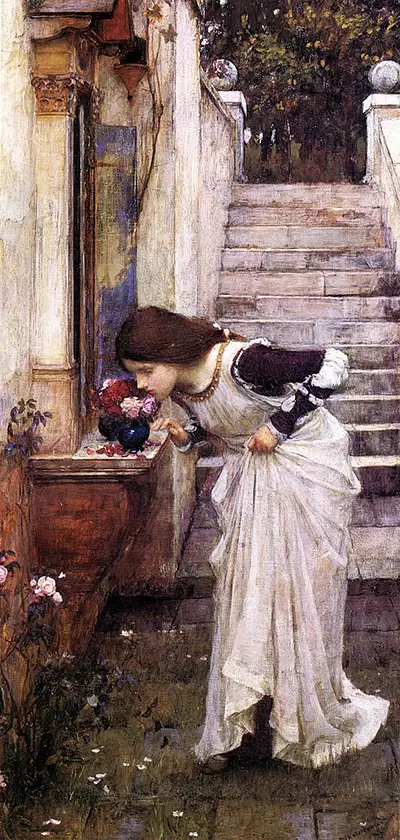Description
This touching scene features a young lady smelling the fresh flowers of a shrine, in front of a small set of steps, perhaps in a quiet spot of a large garden. This delicacy and femininity is entirely typical of the artist and can be witnessed in paintings throughout his career.
The Victorian dress is relatively simple in this composition, as she pulls up her dress to try to avoid the wet paved area around this garden. The architectural touches remind us of Alma Tadema but were also very common in Waterhouse's work during this period of his career. It is possible that rather than a garden, it is actually a particularly ornate graveyard.
Waterhouse liked to make use of private gardens, as well as open spaces in local forests. The former often included touches of architecture which added interest to his work, and that is certainly the case here, in The Shrine. In fact, the title of the work is based around the small feature to the figure's left, as she leans over to smell the fresh flowers.
The steps themselves lead up to another, more open part of the garden, where a series of trees dominate. The same features and colours appear again and again within this artist's career, as he created a particular look which remained consistent throughout. Waterhouse married British landscapes with classical features from Roman times in a blend which drew support with the British public.
The Model
The model herself was one of the Waterhouse's favourites and used her regularly for a period of several years. She perfectly matched his preference for pale skin, with gentle facial features and a slim build but without being skinny. Over time, a number of his favoured muses would become celebrities in their own right and often sat for a variety of different artists.
Closely Aligned to the Pre-Raphaelites
Waterhouse was from the fringes of the Pre-Raphaelite in that he used many of their styles and techniques, but actually arrived a few years after their main exponents had passed by. He was also never a part of the famous Brotherhood, but his work bore many resemblances to it, whilst also drawing on influences from classical art and architecture.
The painting style was similar to realism, but with the content itself being heavily influenced by mythical tales, plus more recent poetry. Compare that to someone like Bouguereau, who was academically trained in France and continued that style into his career. There were, therefore, a number of similiarities with Academic artists in France, and both approaches would fall out of fashion by the start of the 20th century.
Lawrence Alma Tadema is perhaps the most similar in terms of how classical architecture would be used in Victorian art, and both artists made strong careers in working this way. In recent years their work has regained favour, spreading further afield than was the case during their own lifetimes.
Large Image of The Shrine
Find a slightly larger image below of the original painting, helping us to appreciate more of the detail found in the work. Waterhouse would focus most on his portrait figures, but normally there would be plenty of other additions, dotted around each scene. In this case, the steps leading down are particularly memorable, as are the touches of ageing architecture found all along the left hand side of the work.


